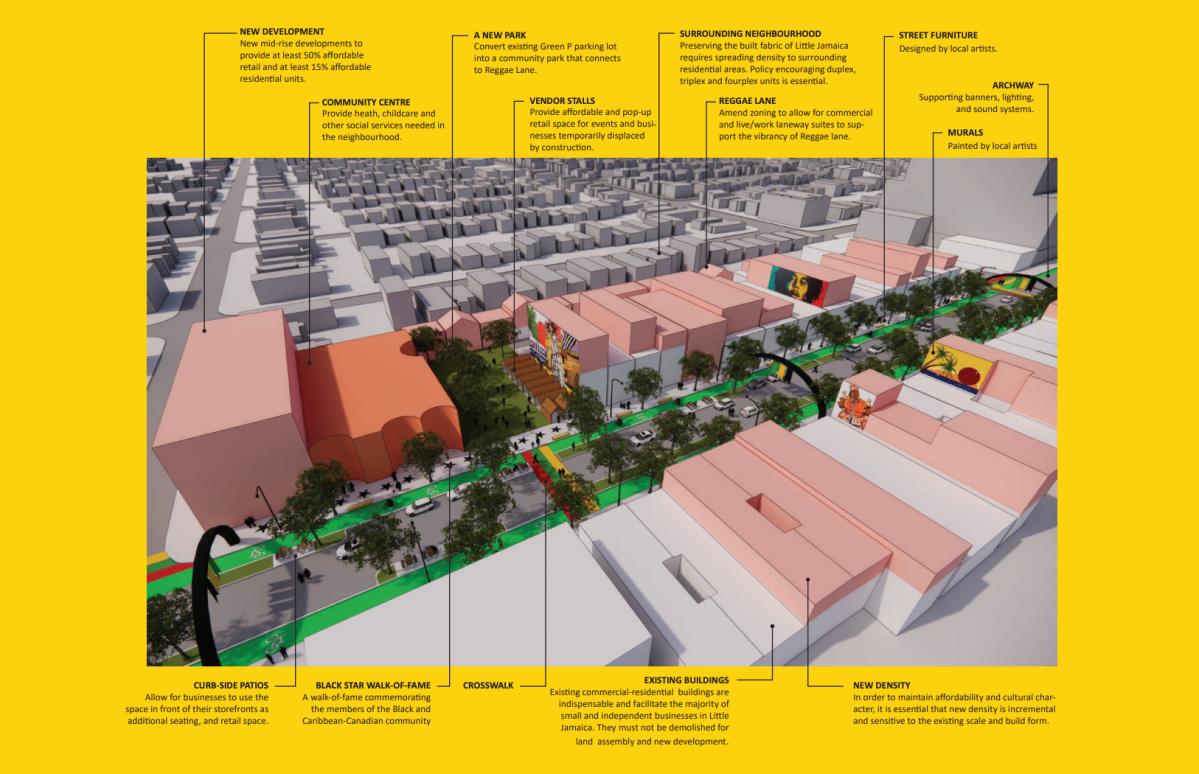For nearly a decade, the noise of construction from the Eglinton Crosstown light-rail transit (LRT) project has rattled the streets of Toronto’s Little Jamaica from Allen Road to Keele Street.

But these days, there’s a different buzz in the air, one of optimism. What is to come had one woman, standing in front of the iconic Randy’s Patties shop, exclaiming, “Finally, this is happening! Finally! This is good news … we’ve been waiting a long time for this.”
She is referring to a new motion adopted recently by Toronto City Council and moved by the area’s councillor, Josh Matlow to study the neighbourhood to become a Heritage Conservation District — which according to the Ontario Heritage Act — would give the city and province powers to put restrictions on demolition.
It is protection the community has long sought.
Matlow and community grassroots organizers like Black Urbanism T.O. have been working diligently to build a plan to protect and preserve Little Jamaica’s rich cultural heritage — which is in danger of disappearing, lost along with many businesses already to the powers of construction, gentrification and the COVID-19 pandemic.
“There is a lot of development that is expected to happen after the LRT is completed,” said Romain Baker, chair and co-founder of Black Urbanism T.O., referring to the Eglinton Connects plan — a plan he said Little Jamaica was left out of.
- ‘Pretty scary’: Ill Ontario man stranded in Costa Rica finally recovering in Canada
- S&P/TSX composite down, U.S. markets mixed ahead of tech earnings and economic data
- 1 deal falls through but Toronto FC completes another in Derrick Etienne Jr. trade
- Big warm-up to follow blast of cold air in southern Ontario
“There is a real fear that these businesses will be displaced and once they are displaced, Little Jamaica as we know it … goes with it,” he said.
Matlow said the roots of this type of displacement in municipal planning runs deeper, with ties to anti-Black racism.
“There is a shameful history in North America and around the world that whenever major infrastructure projects or gentrification is approaching, Black communities are usually the first to be displaced,” said Matlow.
It would be a lot to lose. The rich Caribbean history enshrined in Little Jamaica’s neighbourhood dates back to the 1960s when Jamaican migrants settled in Toronto, transforming the space into a global hotbed for reggae culture.
Jamaican-Canadian historian and longtime resident, Afua Cooper, remembers Little Jamaica’s heyday, well.
“You’d see multi-generations in Little Jamaica–grandparents, parents, children, cousins, everybody,” said Cooper, professor of history, sociology and social anthropology at Dalhousie University.
“The churches were there, it was a real community site … you could speak your language, you could speak the Jamaican Creole or the patois, it was a place where you could just exhale. It was in those moments, you could just be your fully human self,” said Cooper, who remarked on the “largesse” of cultural capital the neighbourhood has outputted too.
“And if we think of, you know, the jerk chicken, the music (reggae is international of course), then you can see some of the contributions that Little Jamaica has made to global mainstream culture.”
Hoping to preserve and celebrate this history while sustaining the area’s Jamaican-Caribbean identity, the City of Toronto will also look at “Supporting Black-Owned and Operated Businesses and Preserving the Cultural Heritage of Eglinton Avenue West’s ‘Little Jamaica‘” — a motion passed recently that takes a holistic approach at creating sustainability and affordability for Little Jamaica beyond the LRT opening, slated for next year. It also would look at designating Little Jamaica as Toronto’s first Cultural District.
One measure being explored is commercial rent control, with the City looking to the province to introduce legislation that would protect existing Black business along the stretch from being priced out.
Other priorities include exploring measures to provide financial relief directly to businesses, developing a strategic plan that focuses on affordable housing and work-live spaces and creating more opportunities for Black ownership.
This will be done by “…requesting that Metrolinx provides retail spaces in the LRT stations to Black-owned and operated businesses first before making it available to other business owners,” Baker explained.
The motion also directed an inter-divisional team of city staff to develop a ‘Cultural District Plan’ for the neighbourhood, ‘using an equity lens’ — reporting back to with a final report by October 2021.
As part of this initiative, staff is directed to consult with the community to investigate ways to rebrand the area in a way that “reflects the Jamaican-Caribbean history” — markers that are noticeably absent on the streets of Little Jamaica today.
“I’d like to see the words Little Jamaica on the signs,” Matlow said. “I’d like to see more done to reflect the identity of Little Jamaica of Little Jamaica in the public realm, in the streetscape of Little Jamaica, along with just making it aesthetically beautiful.”
In addition to this, the motion also directed staff to consult with community members to “bring back previous, and develop new, culturally-focused events and initiatives that will celebrate the Jamaican and Afro-Caribbean cultural heritage of Eglinton Avenue West, before the end of 2021.”
“I think if we bring events, markets, stimulus to Little Jamaica right now, it’ll help the community, but it’ll also bring people and their wallets to Little Jamaica,” said Matlow.
Baker said he believes this plan is possible and executable for Little Jamaica, especially since it has been pulled off in other parts of the city.
“We have examples already existing in the city — whether you’re in Greektown, or Chinatown, you have signage, you have archways, you have the storefronts and the markets that really brings you to a place,” said Baker. “That sense of place already exists in Little Jamaica and what we’re trying to do is enhance it and really allow it to thrive and be the vibrant part of the city that it can become.”
Andre Critchlow, owner of ‘Just Incredible Hair’ which has been on the strip for 30 years, is a little more skeptical of the promises the city is making to protect Little Jamaica, telling Global News he’ll believe it when he sees it.
“What we really need is something to be done now,” Critchlow said. “It’s always slow, there’s always promises, by the time leadership changes, so do the plans. I just want to see actual action happening.”
Defining that action further, he said, “I’d like to see on the map of Toronto, a Little Caribbean, Little Jamaica — what have you – -something that represents the culture in the area…to bring in tourists, to let them know that we’re here, to increase the economy…and to let everyone see the diversity that exists in Toronto.”
As for what’s next, Matlow said the public will be invited to co-author the plan being built for Little Jamaica by taking part in community consultations which continue to rollout next month.






Comments